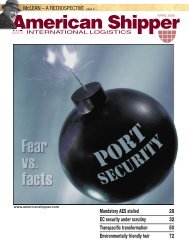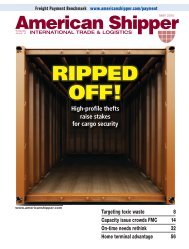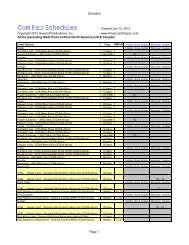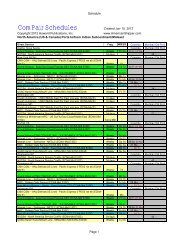Pirate Busters - American Shipper
Pirate Busters - American Shipper
Pirate Busters - American Shipper
Create successful ePaper yourself
Turn your PDF publications into a flip-book with our unique Google optimized e-Paper software.
TRANSPORT / INLAND<br />
Hydro Green prepares installation of its first barge-mounted hydrokinetic<br />
power plant in Hastings, Minn. (Photo: Hydro Green Energy)<br />
Something is quietly stirring in the river<br />
water at Hastings, Minn., just downstream<br />
from the Army Corps of Engineers’ Lock<br />
and Dam No. 2. While it’s not a strange<br />
creature lurking in the depths, it is a new<br />
sight to the waterway’s users.<br />
Earlier this year, Houston-based Hydro<br />
Green Energy installed the first of<br />
two barge-mounted hydrokinetic power<br />
plants. The second unit is expected to<br />
enter service next spring.<br />
Hydrokinetic power refers to the generation<br />
of electricity from moving water<br />
without dams or diversionary structures<br />
typically used at conventional hydropower<br />
plants. Hydro Green’s unit will produce<br />
100 kilowatts of uninterrupted power,<br />
which will feed back to the electric grid.<br />
After extensive testing by the company,<br />
the Federal Energy Regulatory<br />
Commission signed off on the project<br />
in Hastings in December.<br />
The Corps plays a major role in<br />
evaluating and approving these types of<br />
projects. The agency must ensure that any<br />
proposed hydropower-generation equipment<br />
doesn’t hurt the environment or<br />
impede barge traffic. “Anytime we have<br />
the opportunity where we’re not altering<br />
our flows and capacity, it’s something we<br />
like to do,” said Mike Ensch, the agency’s<br />
chief of operations and regulatory.<br />
Hydropower has been added at Corps<br />
dams by local utilities over the years,<br />
such as Canyon and Lewisville, Texas,<br />
42 AMERICAN SHIPPER: OCTOBER 2009<br />
In the depths<br />
Hydrokinetic power plants operate below barge traffic.<br />
and Bluestone, W.Va. Other facilities are<br />
underway by AMP-Ohio at the Smithland<br />
and Cannelton locks and dams, with three<br />
more planned. These facilities were built<br />
on the river banks along the lock and dam<br />
spillways, Ensch said.<br />
Suspended or anchored hydrokinetic<br />
equipment takes advantage of free-flowing<br />
river currents. While the concept is<br />
quite ancient, it has recently become part<br />
of the country’s efforts to develop nonfossil<br />
fuel-based energy sources, such<br />
as wind, solar, biomass and geothermal.<br />
Hydro Green plans to develop hydrokinetic<br />
projects across more than a<br />
dozen states for a total of 500 megawatts<br />
of power.<br />
Other firms are seeking federal approval<br />
to install their own hydrokinetic<br />
equipment in U.S. waterways. Free Flow<br />
Power of Gloucester, Mass., has received<br />
55 FERC permits to conduct tests at Mississippi<br />
River sites between St. Louis and<br />
Plaquemines, La.<br />
Free Flow’s 1.4- and 3-meter-diameter<br />
machines, which resemble wind turbine<br />
blades contained within an open-ended<br />
cylindrical shell, would be attached<br />
several at a time to underwater pylons<br />
well below surface barge traffic.<br />
In a 2007 policy statement, FERC<br />
estimated that hydrokinetic technologies,<br />
combined with the existing hydropower<br />
capacity, could eventually produce 20<br />
percent of the country’s electric supply.<br />
of coal by the time the Greenup lock was<br />
reopened. The Corps estimated that if the<br />
lower gate at Greenup had failed, the main<br />
chamber would have been closed six months<br />
with delays costing the industry upwards<br />
of $75 million.<br />
Mike Ensch, chief<br />
of operations and<br />
regulatory for the<br />
Corps, said the agency<br />
does its best to notify<br />
shippers and barge<br />
operators as far in<br />
advance as possible<br />
to allow them to build<br />
Ensch<br />
sufficient stockpiles of materials. The<br />
Corps provides a composite maintenance<br />
schedule for the next three years, which it<br />
makes available to the industry on its Web<br />
site, he said.<br />
High Demand. Over the years, the<br />
Corps has generally had a good relationship<br />
with the waterways industry. “We have a<br />
good rapport at the local level. I think the<br />
industry knows we try,” Ensch said.<br />
The Corps continues to make upgrades<br />
on locks and dams throughout the inland<br />
waterway system. One of the largest modernization<br />
projects includes the construction<br />
of a new dam with twin 1,200-foot locks<br />
at Olmsted. The agency recently finished<br />
erecting a second 1,200-foot chamber at<br />
McAlpine Locks and Dam. Both structures<br />
are located on the Ohio River.<br />
The agency is also constructing 1,200-<br />
foot chambers at the Kentucky Lock on the<br />
Tennessee River and at the Inner Harbor<br />
Lock on the Gulf Intracoastal Waterway at<br />
New Orleans. Other projects are underway<br />
in Pennsylvania, West Virginia and Tennessee.<br />
Together, this ongoing work represents<br />
an investment of more than $7.2 billion in<br />
inland waterways modernization that will<br />
be completed over the next 10 to 20 years,<br />
depending on the availability of funds, the<br />
Corps noted.<br />
The bigger lock sites are important to<br />
the shipping industry. At the smaller lock<br />
sites, barge operators must “cut” their 12-<br />
to 15-barge tows in half to accommodate<br />
the 600-foot-long passages. This procedure<br />
causes long queues for tows waiting their<br />
turn to move through the lock. In addition,<br />
the delays cost the industry hundreds of<br />
millions of dollars a year.<br />
Other critical projects are authorized or<br />
under study on the Upper Mississippi River<br />
and Illinois Waterway, Ohio River, the Gulf<br />
Intracoastal Waterway, and the McClellan-<br />
Kerr Arkansas River Navigation System.<br />
Corps officials said over the next few years,<br />
these studies will identify navigation and<br />
environmental actions needed to support










